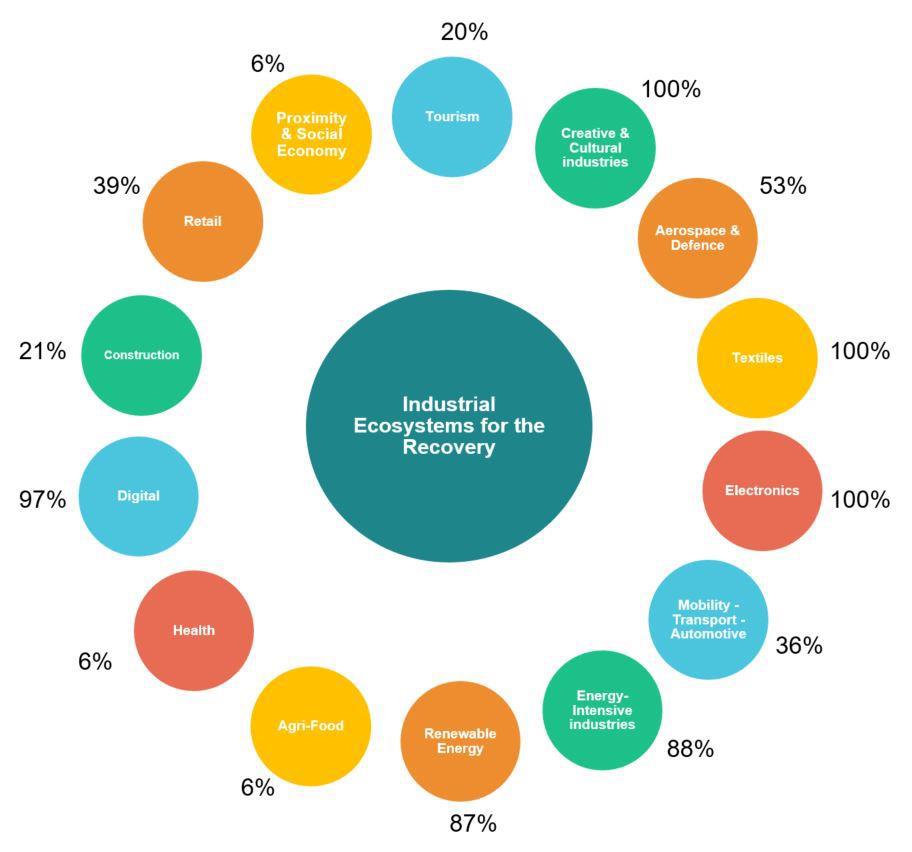The challenge ahead: capitalizing on Europe’s intellectual assets to boost recovery and resilience
Intangible assets such as inventions, artistic and cultural creations, brands, software, knowhow, business processes and data are the cornerstones of today’s economy. Over the last two decades, the volume of annual investments in such ‘intellectual property products’ increased by 87% in the EU, while the volume of tangible (non-residential) investments increased by only 30%. Investments in intangibles were also significantly less affected by the 2008 economic crisis.
In today’s economy, industrial products and processes increasingly rely on intangibles protected by IPRs, and sound intellectual property (IP) management has become part and parcel of any successful business strategy. Industries that make intensive use of IP play an essential role in the EU economy and offer valuable and sustainable jobs to society. IPR-intensive industries currently account for almost 45% of Europe’s GDP and directly contribute to the creation of almost 30% of all jobs.
There have been identified five challenges:
- First, despite a lot of progress, part of the EU’s IP system remains too fragmented, with procedures that are complex and costly and that sometimes lack clarity.
European patents are subject to expensive national validation procedures and parallel litigation in multiple EU countries. For pharmaceuticals, protection through supplementary protection certificates (SPCs) is only available at national level. Design and geographical indication (GI) protection should be improved. Where registration is necessary to protect one’s IPRs, one-stop shop procedures, offering the right coverage, should be the norm, not the exception.
- Second, too many companies, in particular SMEs, and too many researchers do not make full use of the opportunities offered by IP protection.
Only 9% of EU SMEs have registered IP rights. In the current crisis, IP registration numbers have dropped, to the detriment of companies’ competitiveness and resilience. Recent analysis shows that SMEs’ reluctance to use IP rights is largely due to lack of knowledge about IP. Even if they use IPRs, they find the system too costly, complex and difficult to navigate.
In addition to the low levels of protection of their IP, SMEs are not taking full advantage of its commercial exploitation. Knowledge-intensive SMEs seeking to finance their operations often do not adopt appropriate IP strategies that would help valorise their intangible capital.
- Third, tools to facilitate access to IP (and therefore allow the take up and diffusion of technologies) are insufficiently developed.
- Fourth, in spite of continued efforts to turn the tide, counterfeiting and piracy are still thriving, including by taking advantage of digital technologies.
- Finally, there is lack of fair play at global level and EU businesses often lose out when operating abroad.
Certain non-EU countries do not sufficiently protect IP, often to the harm of EU companies. The EU must harness its potential to act as a global norm-setter. It must step up efforts to fight abusive practices, such as bad-faith IP-registrations and other misappropriations of IP. Above all, it should lead by example: develop state-of-the art regulatory solutions to global issues such as the licensing of SEPs or the way data can be shared.
In response to these five challenges, and building on input provided by Member States and stakeholders, this action plan identifies five key focus areas, with specific proposals for action to:
- upgrade the system for IP protection,
- incentivise the use and deployment of IP, notably by SMEs,
- facilitate access to and sharing of intangible assets while guaranteeing a fair return on investment,
- ensure better IP enforcement, and
- improve fair play at global level.
Better protection of IP
A first priority is to ensure that EU innovators have access to fast, effective and affordable protection tools. To make this happen, it is necessary to secure the launch of the unitary patent system. This will create a one-stop shop for businesses, considerably simplifying patenting in the EU, boosting transparency and facilitating licensing.
In addition, centralised litigation before the new Unified Patent Court will improve legal certainty and avoid parallel proceedings in multiple Member States, considerably reducing litigation costs. Closely linked to patents are supplementary protection certificates (SPCs), which offer an additional period of IP protection for patented medicinal and plant protection products that are subject to lengthy clinical trials and market authorisation processes.
The Commission will revise the EU legislation on design protection. The aim is to improve the accessibility and affordability of design protection in the EU, especially for the textile, furniture and electronics ecosystems, and to ensure that the design protection regime better supports the transition to the digital and green economy. Registration procedures are partly outdated and in some cases involve an unnecessary administrative burden.
The protection of new forms of design (e.g. animated designs, graphical user interfaces) is not sufficiently clear. Also, a lack of clarity on the scope of design rights poses challenges, particularily in relation to the increasing use of 3D printing or for the enforcement of design rights against infringing goods transiting the EU.
AI technologies are creating new works and inventions. These developments raise the question of what protection should be given to products created with the help of AI technologies. Whilst inventions and creations autonomously created by AI technologies are still mostly a matter for the future, the Commission takes the view that AI systems should not be treated as authors or inventors. This is also supported by the line taken by the EPO in the Dabus case.
